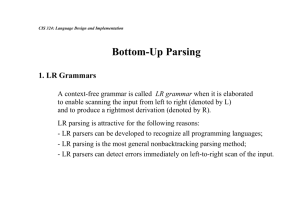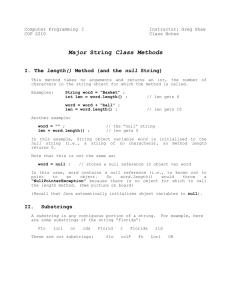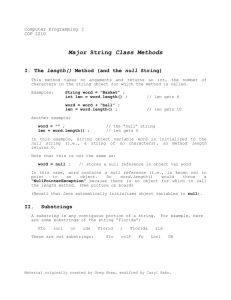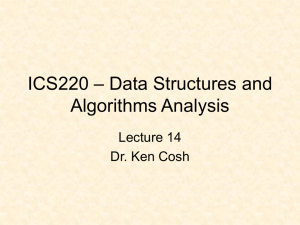11CS10039
advertisement
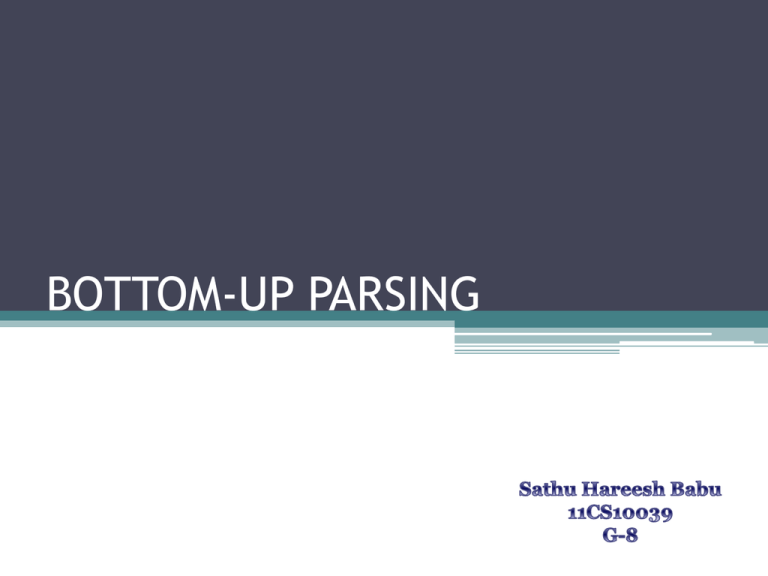
BOTTOM-UP PARSING Bottom-Up Parsing o Bottom-Up Parser : Constructs a parse tree for an input string beginning at the leaves(the bottom) and working up towards the root(the top) o We can think of this process as one of “reducing” a string w to the start symbol of a grammar o Bottom-up parsing is also known as shift-reduce parsing because its two main actions are shift and reduce. At each shift action, the current symbol in the input string is pushed to a stack. At each reduction step, the symbols at the top of the stack (this symbol sequence is the right side of a production) will replaced by the nonterminal at the left side of that production. Shift-Reduce Parsing o A shift-reduce parser tries to reduce the given input string into the starting symbol. a string the starting symbol reduced to o At each reduction step, a substring of the input matching to the right side of a production rule is replaced by the non-terminal at the left side of that production rule. o If the substring is chosen correctly, the right most derivation of that string is created in the reverse order. Rightmost Derivation: * S rm Shift-Reduce Parser finds: ... S rm rm Shift–Reduce Parsing-Example o Consider the grammar S aABe A Abc | b B d Input string : abbcde aAbcde aAde reduction aABe S We can scan abbcde looking for a substring that matches the right side of some production.The substrings b and d qualify.Let us choose left most b and replace it by A,the left side of the production Ab;we thus obtain the string aAbcde.Now the substrings Abc,b and d match the right side of some production.Although b is the leftmost substring that matches the right side of the some production,we choose to replace the substring Abc by A,the left side of the production AAbc.We obtain aAde.Then replacing d by B,and then replacing the entire string by S.Thus,by a sequence of four reductions we are able to reduce abbcde to S Shift–Reduce Parsing-Example o These reductions infact trace out the following right-most derivation in reverse S aAde aAbcde rm abbcde rm aABe rm rm Right Sentential Forms o How do we know which substring to be replaced at each reduction step? Handle o Informally, a “handle” of a string is a substring that matches the right side of the production,and whose reduction to nonterminal on the left side of the production represents one step along the reverse of a rightmost derivation ▫ But not every substring matches the right side of a production rule is handle. o Formally , a “handle” of a right sentential form γ ( ) is a production rule A and a position of where the string may be found and replaced by A to produce the previous right-sentential form in a rightmost derivation of . * S rm A rm then Aβ in the position following α is a handle of αβω o The string to the right of the handle contains only terminal symbols. Example o Consider the example discussed in the beginning,abbcde is a right sentential form whose handle is Ab at position 2.Likewise,aAbcde is a right sentential form whose handle is AAbc at position 2. o Sometimes we say “the substring β is a handle of αβω” if the position of β and the production Aβ we have in mind are clear. Handle Pruning o A rightmost derivation in reverse can be obtained by “handle pruning”.That is,we start with a string of terminals w that we wish to parse.If ω is a sentence of grammar at hand,then ω = γ,where γn is the nth right-sentential form of some as yet unknown rightmost derivation S = 0 1 2 ... n-1 n= rm rm rm rm rm Input string Handle Pruning S = 0 1 2 ... n-1 n= rm rm rm rm rm o Start from n, find a handle Ann in n, and replace n in by An to get n-1. o Then find a handle An-1n-1 in n-1, and replace n-1 in by An-1 to get n-2. o Repeat this, until we reach S. A Shift-Reduce Parser E E+T | T T T*F | F F (E) | id Right-Most Derivation of id+id*id E E+T E+T*F E+T*id E+F*id E+id*id T+id*id F+id*id id+id*id Right-Most Sentential form id+id*id F+id*id T+id*id E+id*id E+F*id E+T*id E+T*F E+T E HANDLE id F T id F Id T*F E+T Reducing Production Fid TF ET Fid TF Fid TT*F EE+T A Stack Implementation of a Shift-Reduce Parser o There are four possible actions of a shift-parser action: 1.Shift : The next input symbol is shifted onto the top of the stack. 2.Reduce: Replace the handle on the top of the stack by the non-terminal. 3.Accept: Successful completion of parsing. 4.Error: Parser discovers a syntax error, and calls an error recovery routine. o o Initial stack just contains only the end-marker $. The end of the input string is marked by the end-marker $. A Stack Implementation of A Shift-Reduce Parser Stack Input $ $id $F $T $E $E+ $E+id $E+F $E+T $E+T* $E+T*id $E+T*F $E+T $E id+id*id$shift +id*id$ +id*id$ +id*id$ +id*id$ Id*id$ *id$ *id$ *id$ id$ $ $ $ $ Action Parse Tree Reduce by Fid Reduce by TF Reduce by ET Shift Shift Reduce by Fid Reduce by TF Shift Shift Reduce by Fid Reduce by TT*F Reduce by E E+T Accept E8 E3 + T2 T5 F1 F4 id id T7 * F6 id


